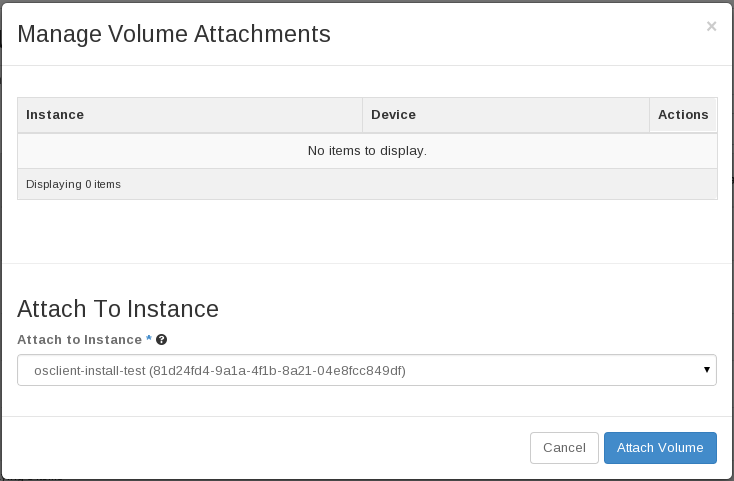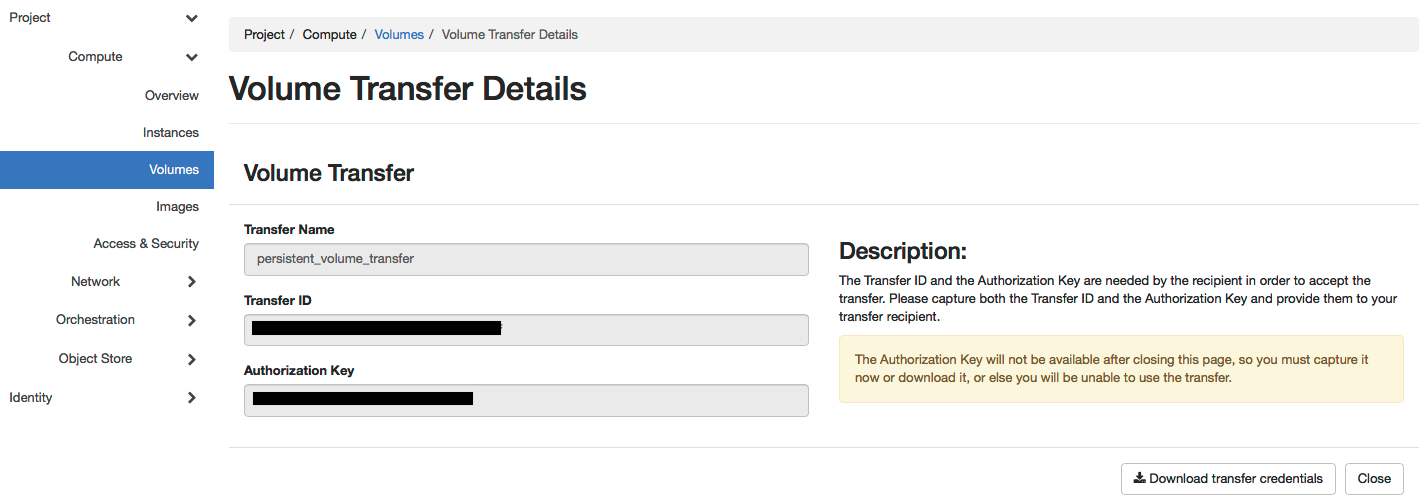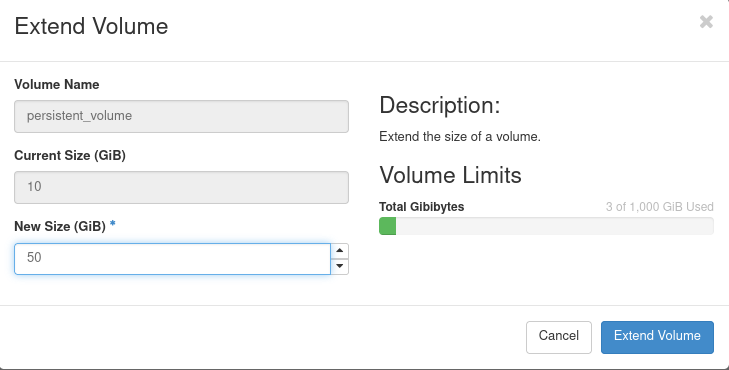Persistent volumes
This article describes one of the options to store data in Pouta which survive turning off the virtual machine.
Persistent volumes, as the name says, remain even when instances are removed. They can be attached to or detached from virtual machines while they are running.
Persistent volumes are using CEPH cluster. Regarding I/O performance, you should not use this kind of volume. It will use network access to the volume therefore latency.
Creating and attaching volumes in the Pouta web interface
Persistent volumes can be created using either the web interface or through the command line interface.
In the web interface, use the Create volume button on the Volumes page to create a new volume. You may then give a name and a size for the volume (1 GB is the minimum). The only mandatory argument is the size of the volume.

Once the volume has been created, it can be attached to a running virtual machine. One volume can be attached to only one virtual machine at a time.
To attach a volume, first select the Volumes view in the Pouta web interface. Click the arrow symbol next to the Edit Volume button for the volume you want to attach and select Manage attachments. Select the instance (i.e. virtual machine) you want to attach the volume to in the Attach to Instance selector.

Using attached volumes
The first time you use a attached volume it needs to be initialized. This should ONLY be done the FIRST time you use it, otherwise you overwrite all your data on the volume. First determine which device is your volume.
The following is a simple usage example for creating a filesystem on a volume and mounting the filesystem automatically after a reboot. Note that this is a simple example and there are many cooler ways to manage your file systems.
Once you have logged in to your virtual machine, you can list the volumes:
sudo parted -l
You should be able to identify the volume based on its size. For this
exercise, let us say it is /dev/vdb. First, we create a file
system on it. We are going to
use xfs because we know it works well in Pouta:
sudo mkfs.xfs /dev/vdb
Now you can start using it. For example, to mount it under
/media/volume, you first need to make sure that the path exists:
sudo mkdir -p /media/volume
Then you can mount it:
sudo mount /dev/vdb /media/volume
Finally, you need to change the ownership to be able to read and write data in it. In the following command, we are assuming the username is cloud-user.
sudo chown cloud-user:cloud-user /media/volume
After this step, you should be able to use your volume normally. Once you are done with your operations and you want to detach the volume, please remember to unmount the volume before detaching it!
sudo umount /dev/vdb
If you want the volume to be available after rebooting the virtual
machine, you need to add it in the /etc/fstab configuration file.
You can use the label you previously created for the partition:
sudo sh -c 'echo "/dev/vdb /media/volume xfs defaults,nofail 0 2" >> /etc/fstab'
Subsequent additions
After you attach the volume to another machine, you only need to run:
mkdir -p /media/volume
mount /dev/vdb /media/volume
After these commands, in order to allow the user of the virtual machine to read and write data on the disk, you might need to give the ownership of the /media/volume folder to the user.
Creating and attaching volumes with command line tools
Persistent volumes can also be created and attached using the command line tools:
openstack volume create --description "<description>" --size <size> <name>
List existing volumes:
openstack volume list
List existing virtual machines to find the one to which you want to attach a volume:
openstack server list
When a volume's status is "available", you can attach it to a virtual machine (you can use either names or IDs to refer to the VM and the volume):
openstack server add volume <virtual machine> <volume>
Info
A volume can only be attached to one virtual machine at a time.
When you no longer need the volume to be attached, you can detach it. Before detaching, remember to unmount the volume's filesystem on the virtual machine to avoid data loss!
openstack server remove volume <server> <volume>
Transferring volumes between other Pouta projects
Occasionally, you may need to transfer your persistent volumes between Pouta projects. For example, you may need to transfer large data sets or bootable volumes to colleagues in another Pouta project. This can be done using volume transfers. Volume transfers between projects in Pouta are fast, avoid data duplication and unnecessary data transfers over the network. Transferring a volume to another project means that your project will no longer have access to it. Please note Pouta volume transfer works within the same cloud environment i.e. you can transfer a volume from one cPouta project to another but not between a cPouta project and ePouta project or vice versa.
To transfer a volume, you must first make sure its status is Available. You can do so by detaching it from the instance to which it was initially attached. Once your volume is in the available status, you can initiate volume transfer either using Pouta Web or the command line interface.
For the Pouta Web interface, go to the Volumes view and click the arrow symbol next to the Edit Volume button of the volume you want to transfer and select Create Transfer. Name this transfer request and click on Create Volume Transfer. You will then get the volume transfer credentials (transfer ID & authorization key).

You need to provide these credentials to your colleague to whom you want to transfer this volume.
Your colleague can accept this volume transfer in his project by going to his Volumes view of the web interface and clicking the Accept Transfer button. They need to then provide the transfer credentials you generated in the previous step and Accept Volume Transfer. This will transfer the volume to your colleague's project.

Volume transfers can be also done using the command line tools:
openstack volume transfer request create <name or UUID of volume to transfer>
The output of this command will have the volume transfer credentials (transfer ID & Authorization key), note them down and pass them to your colleague to whom you want to transfer the volume.
Your colleague can accept the transfer request of this volume:
openstack volume transfer request accept <transferID> <authKey>
Expanding size of the attached volumes in the Pouta web interface
Previously you have created and attached a volume. In this section you are going to enlarge the size of the volume attached to the instance. Before you attempt for volume expansion you have to detach the volume from the instance, please remember to unmount the volume before detaching it!
sudo umount /dev/vdb
To expand the volume, first select the Volumes view in the Pouta web interface. Click the arrow symbol next to the Edit Volume button for the volume you want to enlarge and select Extend Volume. Input the the volume amount you want to enlarge in (GiB) in the field New Size (GiB). Finally, click the Extend Volume button. To attach an expanded volume similar to the previous attach persistent volume, first select the Volumes view in the Pouta web interface. Click the arrow symbol next to the Edit Volume button for the volume you expanded and select Manage attachments. Select the instance (i.e. virtual machine) you want to attach the volume to in the Attach to Instance selector.

Once you have logged in to your virtual machine, you can list the volumes:
sudo parted -l
Similar to the previous persistent volume creation you can identify the volume based on its size. First mount the volume at the usual path:
sudo mount /dev/vdb /media/volume
Finally we need to grow the filesystem of the volume, so that the additional space can be used. Assuming that the filesystem in the volume is xfs, we can grow the filesystem with the following command:
sudo xfs_growfs /dev/vdb
To verify that the filesystem has now the expected size, you can use the following command:
sudo xfs_info /dev/vdb
By multiplying the block size (bs) by the number of blocks in the filesystem (blocks), you will obtain the size of the filesystem in bytes.